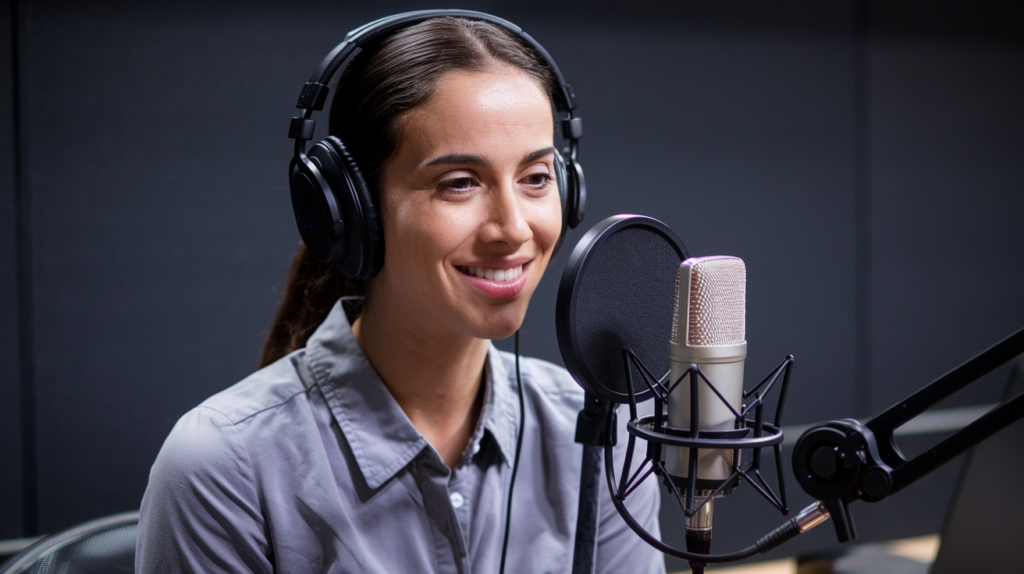Key Takeaways
- Cultural Nuances Matter: Successful dubbing requires a deep understanding of Brazilian cultural references, idioms, and humor to ensure authenticity and relatability for viewers.
- Linguistic Adaptation is Key: Translators must creatively adapt dialogue that preserves emotional weight while avoiding awkward or forced translations into Brazilian Portuguese.
- Technical Precision is Crucial: Synchronizing voiceovers with on-screen action demands skillful timing; any discrepancies can break viewer immersion and affect overall enjoyment.
- Collaboration Enhances Quality: Involving native speakers in the scriptwriting and review process ensures that the content resonates well with local audiences and meets cultural sensitivities.
- Innovative Technology Improves Dubbing: Embracing advanced dubbing technologies enhances synchronization, audio quality, and translation accuracy, leading to a more engaging viewer experience.
Have you ever wondered why some Brazilian Portuguese media just doesn’t hit the mark when dubbed? Dubbing is an art, but it comes with its fair share of obstacles. From cultural nuances to linguistic challenges, the process can be more complex than it seems.
Overview of Dubbing in Brazilian Portuguese Media
Dubbing in Brazilian Portuguese media presents unique challenges that require careful consideration. This process involves not just replacing the original audio with translated lines, but also ensuring that the new voice matches the emotional tone and cultural context of the content.
Voice actors play a crucial role in this artistic endeavor. Selecting skilled voice talent who can convey nuances and emotions effectively is vital for maintaining audience engagement. The right voice artist can elevate a production, making it feel authentic rather than merely translated.
Cultural nuances often complicate dubbing efforts. Certain phrases or idioms may not have direct equivalents in Brazilian Portuguese, requiring creative adaptation to preserve meaning while still resonating with local audiences. This is where experienced voice over artists shine; they understand how to craft dialogue that feels natural and relatable.
Additionally, technical aspects come into play during the dubbing process. Synchronizing dialogue with on-screen action demands precision from both directors and voice over talent alike. Inaccuracies here can detract from viewer experience, leading to disconnection from the story being told.
Overall, successful dubbing hinges on collaboration among writers, directors, and talented voice actors who are attuned to both linguistic intricacies and cultural subtleties. By addressing these obstacles head-on, producers can create dubbed media that truly resonates with Brazilian audiences.
Common Obstacles in Dubbing
Dubbing Brazilian Portuguese media involves navigating several obstacles that can impact the final product. Understanding these challenges is essential for producing high-quality dubbed content that resonates with local audiences.
Cultural Sensitivity Issues
Cultural sensitivity plays a significant role in dubbing. Certain phrases, jokes, or references may not translate well and could even offend viewers if mishandled. A voice actor must grasp the cultural context behind the original material to adapt it effectively. This means understanding local customs, humor, and social norms—elements that vary widely across different regions of Brazil. When voice talent captures these nuances, the result feels authentic and relatable to the audience.
Linguistic Challenges
Linguistic challenges are another major hurdle in dubbing. Brazilian Portuguese has its unique idiomatic expressions and slang that often lack direct equivalents in other languages. Voice actors must be skilled at creatively adapting dialogue while preserving its intended meaning and emotional weight. For instance, what might sound natural in English could seem awkward or forced when translated directly into Portuguese. Writers need to craft scripts that allow voiceover talent to deliver lines naturally without losing the essence of the original content.
Technical Limitations
Technical limitations also affect dubbing quality. Synchronizing dialogue with on-screen action requires precise timing from both directors and voice artists. Inconsistent lip movements or mismatched audio can break immersion for viewers, making them acutely aware they’re watching a dubbed version rather than an original performance. High-quality sound equipment and editing software help mitigate these issues, but they demand skillful operation by professionals who understand both technical aspects and artistic expression.
By addressing cultural sensitivity issues, linguistic challenges, and technical limitations head-on, you position your dubbed media for greater success among Brazilian audiences.
Impact on Audience Reception
Dubbing Brazilian Portuguese media significantly affects how audiences perceive and connect with content. Attentive adaptation to cultural nuances ensures that viewers remain engaged.
Viewer Expectations
Viewers anticipate authentic voice performances that reflect their culture and idioms. When they hear a voice actor, they expect the delivery to resonate emotionally, matching the original tone while also fitting local expectations. If a voiceover lacks this authenticity, it risks alienating the audience. The choice of voice talent becomes crucial; selected actors must embody characters convincingly to maintain viewer immersion.
Changes in Narrative Authenticity
Narrative authenticity often shifts during dubbing due to language constraints or cultural adaptations. While translating lines accurately is essential, preserving the essence of storytelling matters just as much. Some jokes or references may not translate well into Brazilian Portuguese, leading to altered meanings or diminished humor. This adjustment can change how audiences interpret characters and storylines, affecting overall reception. Voice artists need an understanding of both the source material and local context for effective adaptation without losing narrative integrity.
By addressing these factors thoughtfully, you enhance audience engagement through high-quality dubbing that resonates culturally and emotionally with Brazilian viewers.
Strategies to Overcome Dubbing Obstacles
Addressing the challenges in dubbing Brazilian Portuguese media requires strategic approaches. By implementing effective strategies, you can enhance the quality of your dubbed content and improve audience engagement.
Collaboration with Native Speakers
Collaborating with native speakers serves as a cornerstone for successful dubbing. Native voice actors bring an authentic understanding of cultural nuances and idiomatic expressions that non-native talent might miss. Involving these individuals during scriptwriting ensures that translations resonate well with local audiences. For example, they can suggest alternatives for jokes or references that wouldn’t translate effectively, helping to maintain humor and emotional impact.
Additionally, involving native speakers in the review process helps identify potential pitfalls before final production. Their insights on voiceover delivery ensure that performances align perfectly with local expectations and sensitivities, ultimately leading to a more relatable product.
Innovations in Dubbing Technology
Embracing innovations in dubbing technology significantly enhances the dubbing process. Advanced software tools offer improved synchronization between dialogue and on-screen action, making it easier to achieve natural flow. These technologies allow for precise timing adjustments, ensuring that voiceovers match lip movements seamlessly.
Moreover, artificial intelligence (AI) tools can assist in generating context-appropriate translations faster than traditional methods while preserving narrative integrity. This approach not only streamlines workflow but also allows for quicker turnaround times—an essential factor in today’s fast-paced media environment.
Integrating cutting-edge sound engineering techniques improves overall audio quality too. Enhanced sound design contributes to immersive viewer experiences by ensuring clarity and depth in voice performances. When you leverage such innovations effectively, you create high-quality dubbed content that captures attention and keeps viewers engaged from start to finish.
Conclusion
Navigating the intricacies of dubbing Brazilian Portuguese media is no small feat. You must consider cultural nuances linguistic challenges and the technical aspects that contribute to a successful adaptation. The right voice talent can make all the difference in delivering an authentic experience that resonates with viewers.
By prioritizing collaboration with native speakers and embracing innovative technology you can overcome these obstacles effectively. This strategic approach not only enhances the quality of dubbed content but also ensures that it connects emotionally with your audience. Ultimately focusing on authenticity will lead to more engaging storytelling and a deeper connection with Brazilian viewers.
Frequently Asked Questions
What are the main challenges in dubbing Brazilian Portuguese media?
Dubbing Brazilian Portuguese media involves various challenges such as cultural nuances, linguistic difficulties, and the need for emotional tone matching. Voice actors must convey local customs and humor while adapting scripts that preserve the original content’s essence.
Why is voice talent selection important in dubbing?
Choosing skilled voice actors is crucial because they need to effectively convey emotions and cultural context. The right talent can maintain audience engagement by delivering authentic performances that resonate with local viewers.
How do cultural nuances affect dubbing?
Cultural nuances play a significant role in dubbing as certain phrases or jokes may not translate well. Understanding local customs and social norms helps ensure that adaptations feel authentic, preventing potential misunderstandings or offense.
What linguistic challenges arise during the dubbing process?
Linguistic challenges include unique idiomatic expressions and slang in Brazilian Portuguese that lack direct equivalents in other languages. Writers must craft scripts allowing natural delivery while preserving narrative integrity.
How does dubbing impact audience reception?
Dubbing can significantly influence audience reception; viewers expect authentic performances reflecting their culture. A lack of authenticity can alienate audiences, making it essential for voice artists to embody characters convincingly.
Why is collaboration with native speakers important in dubbing?
Collaborating with native speakers ensures an accurate understanding of cultural nuances and idiomatic expressions during scriptwriting and review processes. This approach enhances translations, making them more relatable to local audiences.
What role does technology play in improving dubbed content?
Technology enhances dubbed content quality through advanced software tools for dialogue synchronization and AI-generated translations. Innovations also improve audio quality, contributing to immersive viewing experiences for Brazilian audiences.







